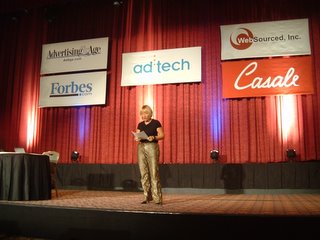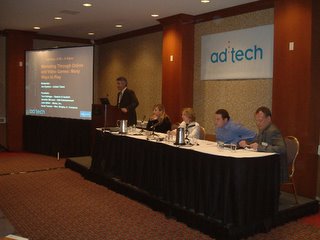
AdTech NY Nov 8, 2005
Cindy Gallup former chair of BBH, offered her contrarian point of view that the consumer is not in control (as was forcefully argued in many of the search marketing sessions), but argued that consumer buying behavior is more influenced by “social endorsement”. “What other people thinks matters to consumers” and drives many purchase decisions. Case studies were presented from Seattle’s own “Ranier Beer” campaign to re-ignite a long dormant brand that still inspired passioned response from loyal customers. Virgin Airlines “Porn Movie,” with tongue firmly planted in cheek, promotes first class luxury to male business travelers by way of the “special attention to service” lavished on male recipients stereo-typically—and quite humorously-- associated with behavior celebrated in the trashiest of porn movies. Gallup argued that Virgin’s use of humor created an intimate bond with viewers who were in on the joke and would share their experience of the humor with other business-traveler colleagues.
James Surowiecki, author of The Wisdom of Crowds expounded on this theme of social engagement putting forward his theory of “collective intelligence”. Citing numerous examples where crowds have a higher success rate in predicting outcomes than individual experts (horse races, internal stock markets, presidential caucuses, HP’s employee market forecasts, “Ask the Audience” technique on “Millionaire), Surowiecki urged marketers to go beyond suggestion boxes and focus groups if marketers want better predictors of a new product or service’s success stating “Customers are the best source of information for determine what OTHER customers will want.” To tap into this cognitive intelligence, markets must create the right set of conditions to extract accurate forecasts:
1) Establish a method to aggregate the data
2) Insure that your audience includes a diversity of perspectives and information about the subject
3) Provide a vehicle to enable and record independent and individual decision making from each participant
Businesses that are adopting this approach include Hollywood Site Exchanges whose members more accurately predict success/failure of Hollywood releases better than the studios that produce the movie; Google’s page rank algorithm reveals “hidden order behind the chaos” of consistently retrieving relevant search results; Brainjuicer.com taps into collective intelligence to predict consumer behavior.
Stimulated with these fresh ideas, we headed back to the booth and our respective customers appointments. The “penthouse suite” continued to alternately impress and amuse client visitors. The sheer spaciousness of the penthouse with its jaw dropping views of mid-town and Central Park combined with the spare and faded glory of the furnishings, create quite a contrast, but never detracted from the conversations we had with customers. The grand piano perched at the edge of the window, on the other hand, proved quite a distraction for yours truly as I longed to tickle the ivories… ah well, next time! (maybe I’ll sneak in a moonlight serenade…)

View from the Penthouse, NY Hilton, Nov 8, 2005
In a seminar titled, “Search Beyond Direct Marketing” Joe Pilotta from BigResearch and an analyst from Piper Jaffrey cited some global market stats/projections and the implications for the current and future search marketing industry:
- Paid search will grow to a $30BB by 2010
- Online advertising will grow to $23BB by 2010
- Search is customer acquisition AND product purchase
- Search re-inforces other campaigns and messages delivered by brands in other media
- Search is uniquely designed to deliver call to action
However, advertisers would be remiss if they extract from these stats an overly rosey forecast of what they can expect search marketing to produce. Joe Pilotta provided these stats with some sobering statistics about the 18-34 year old demographic that marketers mistakenly see as a gold mine waiting to be mined through search marketing:
• Facts about the 18-34 demo:
• Average annual savings rate is -1%
• Average credit card debt is $12,000
• More than 50% will not have the resources to pay off their college loans
• Traditional word of mouth is more influential than purchase decisions than search, internet and email combined.
Pilotta offered these stats and warned marketers to not believe the hype of search marketing and instead recommending that “search should not be used as a standalone, but be used synergistically with other media types” to reach the desired audience. He was also critical of the hype around “behavioral targeting.” Behavioral targeting “is irrelevant if as a marketer you do not know where the consumer has been before they got there.” Given the “consumer interest index” (CII) feature of MetricsDirect newly launched behavioral product which tracks and stack ranks consumer behavior for up to 14 days before presenting an ad, Pilotta’s threshold for delivering effective targeted ads would be greatly exceeded. (Note: Before exiting the seminar, Pilotta was promised by yours truly to get a demo of the new MD behavioral product for review and comment.)
Keeping in mind Zango’s efforts in the games business, we eagerly anticipated the comments and observations from the panelists delivering a presentation on “Games As Marketing Vehicles.” The panel was kicked off with some market sizing stats:
• AdverGaming is a mainstream sponsor driven medium
• Funding continues to pour into the space (DoubleFusion announced this week a $10MM round)
• IGN, interactive game agency sold for $650MM
• Demographics of gamers highly sought after by marketers
• Ubiquitous broadband fueling adoption and reach
• Ad Agencies are opening dedicated AdverGaming divisions
• Avg gamer spends >1 hour per day as compared to ~3 hours/day for the average television viewer
• Jupiter forecasts 360MM online gamers WW by 2009
The speakers including former VP Marketing for Xbox, Julia Miller, now CEO of iBloks, were quick to point out that the hardcore gamer community, while very dedicated are not to be construed as the only gamers online. Women are increasingly apt to spend discretionary time gaming and are twice as likely as men to download mobile games. Jennifer Mekon, VP of IGN Entertainment, a games promotions company, pointed out that games define the audience and therefore make for a particular effective advertising medium for targeting specific demographics. Eg: Need to reach female >35 yo, sponsor Mahjong game. Marketers however cannot dismiss the strong community attribute of gamers. Promotions must be consistent with the values of the demographic and transparent in their intent– i.e. if users already have the full version of a game, why would they would want to download a sponsor laden version? And be warned, as quickly as the community will praise a game product for it’s skill-challenging innovations, they will also just as quickly—and vocally-- disparage what are seen as transparent attempts at exploitation of their community.
Recognizing this attribute of the community, Scott Tannen, VP of Games at Wrigley, and operator of game site candystand.com, recommended “that advertisers who want to enter the game space, should build the game first and then attempt to brand the game experience” once development is complete. Shallow attempts such as Tide detergent’s “shoot out the stains” game are seen as completely one dimensional and therefore completely irrelevant to both the casual and sophisticated gamer. “The game and the experience always take priority in the mind of the gamer.”
This last point in particular really struck home as we identify and evaluate potential content partners in the game space who may wish to exploit the revenue potential of distributing Zango, but may not create sufficient value in the mind of the consumer.

Panelists for “Marketing Through Online & Video Games” seminar. Nov 8, 2005
Under the heading “save the best for last” the closing keynote, and most highly anticipated, was delivered by Guy Kawasaki, founding partner of Garage Ventures and former VP Marketing of Apple Computers. Reflecting on how marketers primary role is that of “evangelist” Guy provided his “10 Rules of Evangelism” as inspired by Constantine Brancusi’s quote; “Create like a god, rule like a king and work like a slave.”

Guy Kawasaki delivers his “10 Rules of Evangelism.” Nov 8, 2005
“Create Like a god.”
1) Kill the cash cows. Have the courage and foresight to go against conventional wisdom. Eg: Apple’s software division was completely isolated from the MacII hardware group so as to reinvent the software with no reliance on the hardware which at the time was 100% of Apple’s revenues.
2) Make Meaning. Make the world a better place. End bad things, make things good or make things better. Eg: Nike converted, cotton, rubber and plastic into meaning (women’s shoe campaign)
3) Jump to the Next Curve. Do things 10x better not 10% better. Eg: HP didn’t attempt to create a better daisy wheel printer; they created laser printers.
“Rule Like a king.”
4) Follow the 10/20/30 rule. Receiving 100s of presentations every week, Guy knows what makes for an effective evangelist’s pitch: Never have more than 10 slides in your presentation. Deliver your entire presentation in 20 minutes. Use a type size that is at least 30 points.
5) Make a Mantra. Explain why you exist not a MBA-style mission statement. Eg: Wendy’s: Healthy Fast Food. FedEx: Peace of Mind. Nike: Authentic Athletic Performance. Target: Democratic Design
6) Niche Thyself. Make sure your idea ranks high on the matrix of “Ability to provide unique product or service” as it relates to “Value to the customer”. Dell offered little that was unique, but was high value to the customers and competes on price. “Stupid” companies offer something unique that has little value to customers. Majority of “Dotcoms” delivered little that was unique and little value. But “Bullseye” companies (Fandango, FilmLoop) deliver something that is at once unique and has high value.
“Work like a slave.”
7) Sow entire fields. Don’t sweat when customers buy your product and you don’t know why. Embrace it and learn.
8) Provide a slippery slope. Don’t make it easy to be copied or replicated.
9) Don’t ask anyone to do something that you would not be willing to do.
10) Ignore Bozos: Thomas Watson, IBM “There are 4 customers who will buy computers.” (1945) Digital Equipment Company CEO “No one will ever buy a computer for their home.” (1977). “That job is too far from my home and I will not commute one hour to get there.” The reason Guy Kawasaki offered in 1996 for not accepting the CEO position at Yahoo!
Guy’s passion, intellect and generous use of humor were on display during the 40 minutes he was on the stage. In closing, Guy provided all attendees with complementary copies of his new book The Art of the Start. Everyone left the auditorium with a palpable sense of excitement and re-newed energy. Guy’s insight and passion for evangelism provided the perfect exclamation point to an exhilarating set of experiences that were AdTech NY 2005.




No comments:
Post a Comment